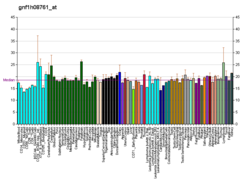Protein-coding gene in humans
| FBXW8 |
|---|
|
| Identifiers |
|---|
| Aliases | FBXW8, FBW6, FBW8, FBX29, FBXO29, FBXW6, F-box and WD repeat domain containing 8 |
|---|
| External IDs | OMIM: 609073; MGI: 1923041; HomoloGene: 17731; GeneCards: FBXW8; OMA:FBXW8 - orthologs |
|---|
| Gene location (Human) |
|---|
 | | Chr. | Chromosome 12 (human)[1] |
|---|
| | Band | 12q24.22 | Start | 116,910,950 bp[1] |
|---|
| End | 117,031,148 bp[1] |
|---|
|
| Gene location (Mouse) |
|---|
 | | Chr. | Chromosome 5 (mouse)[2] |
|---|
| | Band | 5|5 F | Start | 118,203,030 bp[2] |
|---|
| End | 118,293,529 bp[2] |
|---|
|
| RNA expression pattern |
|---|
| Bgee | | Human | Mouse (ortholog) |
|---|
| Top expressed in | - stromal cell of endometrium
- gonad
- ventricular zone
- bone marrow cells
- islet of Langerhans
- ganglionic eminence
- epithelium of colon
- testicle
- popliteal artery
- tibial arteries
|
| | Top expressed in | - otic vesicle
- otic placode
- saccule
- interventricular septum
- internal carotid artery
- external carotid artery
- somite
- calvaria
- yolk sac
- lumbar spinal ganglion
|
| | More reference expression data |
|
|---|
| BioGPS |  | | More reference expression data |
|
|---|
|
| Gene ontology |
|---|
| Molecular function | - protein binding
- ubiquitin-protein transferase activity
| | Cellular component | - perinuclear region of cytoplasm
- Golgi apparatus
- Cul7-RING ubiquitin ligase complex
- SCF ubiquitin ligase complex
- 3M complex
- cytoplasm
- cytosol
| | Biological process | - cell population proliferation
- positive regulation of dendrite morphogenesis
- spongiotrophoblast layer development
- labyrinthine layer blood vessel development
- Golgi organization
- protein ubiquitination
- protein polyubiquitination
- post-translational protein modification
- positive regulation of transcription factor catabolic process
| | Sources:Amigo / QuickGO |
|
| Orthologs |
|---|
| Species | Human | Mouse |
|---|
| Entrez | | |
|---|
| Ensembl | | |
|---|
| UniProt | | |
|---|
| RefSeq (mRNA) | | |
|---|
| RefSeq (protein) | | |
|---|
| Location (UCSC) | Chr 12: 116.91 – 117.03 Mb | Chr 5: 118.2 – 118.29 Mb |
|---|
| PubMed search | [3] | [4] |
|---|
|
| Wikidata |
| View/Edit Human | View/Edit Mouse |
|
F-box/WD repeat-containing protein 8 is a protein that in humans is encoded by the FBXW8 gene.[5][6][7]
This gene encodes a member of the F-box protein family, members of which are characterized by an approximately 40 amino acid motif, the F-box. The F-box proteins constitute one of the four subunits of ubiquitin-protein ligase complex called SCFs (SKP1-cullin-F-box), which function in phosphorylation-dependent ubiquitination. The F-box proteins are divided into three classes: Fbws containing WD-40 domains, Fbls containing leucine-rich repeats, and Fbxs containing either different protein-protein interaction modules or no recognizable motifs. The protein encoded by this gene contains a WD-40 domain, in addition to an F-box motif, so it belongs to the Fbw class. Alternatively spliced transcript variants encoding distinct isoforms have been identified for this gene.[7]
References
- ^ a b c GRCh38: Ensembl release 89: ENSG00000174989 – Ensembl, May 2017
- ^ a b c GRCm38: Ensembl release 89: ENSMUSG00000032867 – Ensembl, May 2017
- ^ "Human PubMed Reference:". National Center for Biotechnology Information, U.S. National Library of Medicine.
- ^ "Mouse PubMed Reference:". National Center for Biotechnology Information, U.S. National Library of Medicine.
- ^ Cenciarelli C, Chiaur DS, Guardavaccaro D, Parks W, Vidal M, Pagano M (Dec 1999). "Identification of a family of human F-box proteins". Curr Biol. 9 (20): 1177–9. Bibcode:1999CBio....9.1177C. doi:10.1016/S0960-9822(00)80020-2. PMID 10531035. S2CID 7467493.
- ^ Winston JT, Koepp DM, Zhu C, Elledge SJ, Harper JW (Dec 1999). "A family of mammalian F-box proteins". Curr Biol. 9 (20): 1180–2. Bibcode:1999CBio....9.1180W. doi:10.1016/S0960-9822(00)80021-4. PMID 10531037. S2CID 14341845.
- ^ a b "Entrez Gene: FBXW8 F-box and WD repeat domain containing 8".
Further reading
- Tsutsumi T, Kuwabara H, Arai T, et al. (2008). "Disruption of the Fbxw8 gene results in pre- and postnatal growth retardation in mice". Mol. Cell. Biol. 28 (2): 743–51. doi:10.1128/MCB.01665-07. PMC 2223430. PMID 17998335.
- Koch HB, Zhang R, Verdoodt B, et al. (2007). "Large-scale identification of c-MYC-associated proteins using a combined TAP/MudPIT approach". Cell Cycle. 6 (2): 205–17. doi:10.4161/cc.6.2.3742. PMID 17314511.
- Gerhard DS, Wagner L, Feingold EA, et al. (2004). "The status, quality, and expansion of the NIH full-length cDNA project: the Mammalian Gene Collection (MGC)". Genome Res. 14 (10B): 2121–7. doi:10.1101/gr.2596504. PMC 528928. PMID 15489334.
- Watanabe N, Arai H, Nishihara Y, et al. (2004). "M-phase kinases induce phospho-dependent ubiquitination of somatic Wee1 by SCFbeta-TrCP". Proc. Natl. Acad. Sci. U.S.A. 101 (13): 4419–24. Bibcode:2004PNAS..101.4419W. doi:10.1073/pnas.0307700101. PMC 384762. PMID 15070733.
- Ota T, Suzuki Y, Nishikawa T, et al. (2004). "Complete sequencing and characterization of 21,243 full-length human cDNAs". Nat. Genet. 36 (1): 40–5. doi:10.1038/ng1285. PMID 14702039.
- Dias DC, Dolios G, Wang R, Pan ZQ (2003). "CUL7: A DOC domain-containing cullin selectively binds Skp1.Fbx29 to form an SCF-like complex". Proc. Natl. Acad. Sci. U.S.A. 99 (26): 16601–6. doi:10.1073/pnas.252646399. PMC 139190. PMID 12481031.
- Strausberg RL, Feingold EA, Grouse LH, et al. (2003). "Generation and initial analysis of more than 15,000 full-length human and mouse cDNA sequences". Proc. Natl. Acad. Sci. U.S.A. 99 (26): 16899–903. Bibcode:2002PNAS...9916899M. doi:10.1073/pnas.242603899. PMC 139241. PMID 12477932.


















